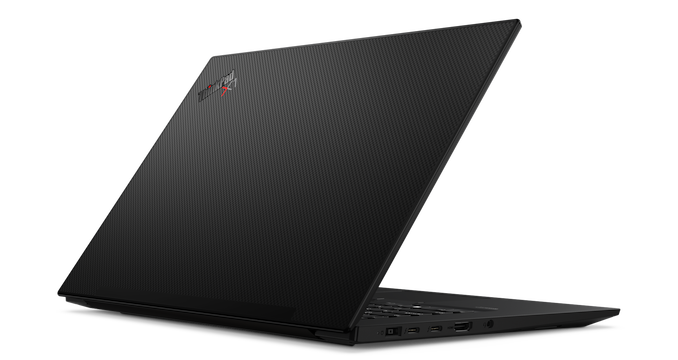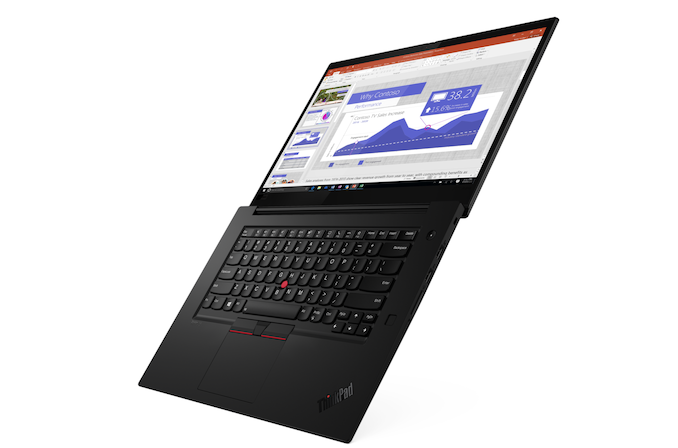Lenovo Unveils ThinkPad X1 Extreme Gen3: 45 W Core i9, 15.6-inch, 1650Ti
by Dr. Ian Cutress on June 17, 2020 9:00 AM EST_678x452.png)
For the high-performance commercial space, the line of Extreme Lenovo ThinkPads is a popular choice. For the current generation, Lenovo is unveiling a new X1 Extreme Gen3 version specifically for those commercial users that need performance from both the CPU and GPU in a typical ThinkPad style design. Highlights include the Intel Core-H series processor, the optional NVIDIA GeForce 1650Ti graphics, a 600-nit 15.6-inch display, as well as Wi-Fi 6 capabilities and an optional Cat16 LTE modem.
The new ThinkPad rotates out to a full 180-degree stance, with the bottom of the screen helping left the laptop to create airflow when at a more userfriendly angle. The X1 Extreme Gen3 will have a multitude of ports, including a card reader, two Type-A ports, two Type-C ports, a built in full-sized HDMI port, a 3.5mm jack, and Lenovo’s custom power connector. The company hasn’t released all the specifications yet, so we might expect to see Thunderbolt 3 support and additional Type-C charging perhaps.
New to some of Lenovo’s designs is its new Ultra Performance Mode, which is set to be exclusive to the Extreme and the ThinkPad P series. This will cause the system to enable higher power limits and higher thermal limits, as well as locking the hardware in at high frequencies, such that when it is critical for a render to complete on time or for a VR experience to not drop, these systems are capable (noise and thermals permitting). It will be interesting to see what this does above the standard Windows Ultimate Performance power mode.
Unfortunately Lenovo isn’t releasing too many details on its new X1 Extreme Gen3 just yet, indicating that it was perhaps planning to show an early engineering sample at what would have been the traditional Computex trade show a couple of weeks ago. The company states that the ThinkPad X1 Extreme Gen3 will be available from July, Price TBD.







_thumb.png)
_carousel_thumb.png)
_carousel_thumb.png)
_carousel_thumb.png)








22 Comments
View All Comments
Xajel - Wednesday, June 17, 2020 - link
I know OEMs were surprised by how Ryzen 4000 APU's performed and how much consumers actually liked and wanted it, and most of them didn't have anytime to tweak their special intel designs to use this new chip.But, seriously, the ThinkPad X1 Extreme, XPS 15/17 and the MBP 16 are just few of the laptops I really wish to have a Ryzen 4000H series APU's inside them. Even thought with the rumours Apple is moving away from x86, it's hard to think they will do another jump in the short term. intel made them sick of x86 and they already love depending and developing everything by them selfs to control everything.
NICOXIS - Wednesday, June 17, 2020 - link
I wonder when did AMD start to sample Ryzen 4000 APU to OEMs... probably in Q2 2019? not sure if "surprise" is the right term, rather fear of disturbing Inteljeremyshaw - Wednesday, June 17, 2020 - link
I'd guess the lack of PCIe lanes did this one in, for high end laptops.Old APUs were 12 lanes, and nobody is speaking about the lane count on newer ones.
Even if we add another 4, we have to split it amongst:
GPU, NVMe (2 of them, in the X1 Extreme), Thunderbolt 3, SD (fast ones, anyways), WiFi, GbE LAN (the X1E and P1 still include an internal NIC and use a breakout cable), etc.
With the Intel H series, you have 16 lanes from the CPU + whatever amount from the southbridge. AMD doesn't use a southbridge, so that's all you get. It's not even a bandwidth question at this stage, rather "will I have enough PCIe ports to even connect all of the onboard devices?"
Speaking of bandwidth, eGPUs have shown bandwidth scaling is a problem at x4, especially if you pump the video frames back over the PCIe bus (muxless Optimus). This means x8 is basically the minimum for any GPU worth putting in a laptop.
After all is said and done, AMD just needs more onboard interfaces. Their SERDES can already handle 10GbE, but it's never exposed for anything outside of the D series CPUs.
For laptops without dGPU options, who knows? IMO, AMD should have focused there, and created actually useful reference platforms and provided engineering support. The whole APU H series targets and plans, all seemed like a mistake to me. Only one laptop even implemented Smartshift, and it is a vastly inferior laptop that has no headroom for smartshift to operate in.
lightningz71 - Wednesday, June 17, 2020 - link
I don't think that Renoir is particularly hurting for PCIe lanes. There is a spec update that gives the die the full x16 for the first PCIe slot, which can be bifurcated with UEFI support. It continues to include the x4 link to the chipset that can be repurposed for any other PCIe device, like an M.2. It continues to have the initial x4 link for the M.2 In addition to the internal support for other I/O features, there are precious few cases where a laptop will require more PCIe lanes than Renoir has.jeremyshaw - Wednesday, June 17, 2020 - link
Renoir doesn't have a chipset. We don't even know if it has 16 lanes, since AMD is extremely stingy with that sort of information, and reviewers don't care to check. We do know previous APUs had 12 lanes.hanselltc - Thursday, June 18, 2020 - link
Renoir does have a chipset. It uses promontory, same chip as 300/400 series chipsets. Saw it present in Renoir laptops' HWinfo reports.jeremyshaw - Friday, June 19, 2020 - link
You're telling me Renoir uses a 55nm chipset that draws more power than an entire Zen2 CPU core? All for a few PCIe 2.0 lanes and a few USB controllers?HWInfo was also written by the same person who claimed AMD engineers didn't know how to calculate the power of their own Zen chips, and that HWInfo's laughably low power figures were the correct ones. Of course, he was completely wrong, and AMD's own uProf tool was correct (this was before Ryzen Master).
I should note, HWInfo 6.26 also reports my Zen2 CPU with X570 Mobo as using Promontory ;).
Meaker10 - Saturday, June 20, 2020 - link
External GPUs are mostly limited by latency of the thunderbolt controller more than the bandwidth.yeeeeman - Wednesday, June 17, 2020 - link
The amount of people shitting about this subject is just massive. OEMs don't just go and buy some parts from AMD and put them in their future laptops. Laptops need to be designed for a specific platform and if amd doesn't have enough field engineers and money to support oems during development they won't get designs. Is that so hard to understand for f***** sake?hanselltc - Thursday, June 18, 2020 - link
Lenovo is among the first adoptors of raven when zen APU first arrived with thinkpad A stuff, and by picasso they put them in E and T laptops with the same chassis. Other than v pro which is intel's tech, tb3 and a 4k screen on t495, for the common business man the picasso T and E laptops could've been configured to feature parity while being cheaper and faster.